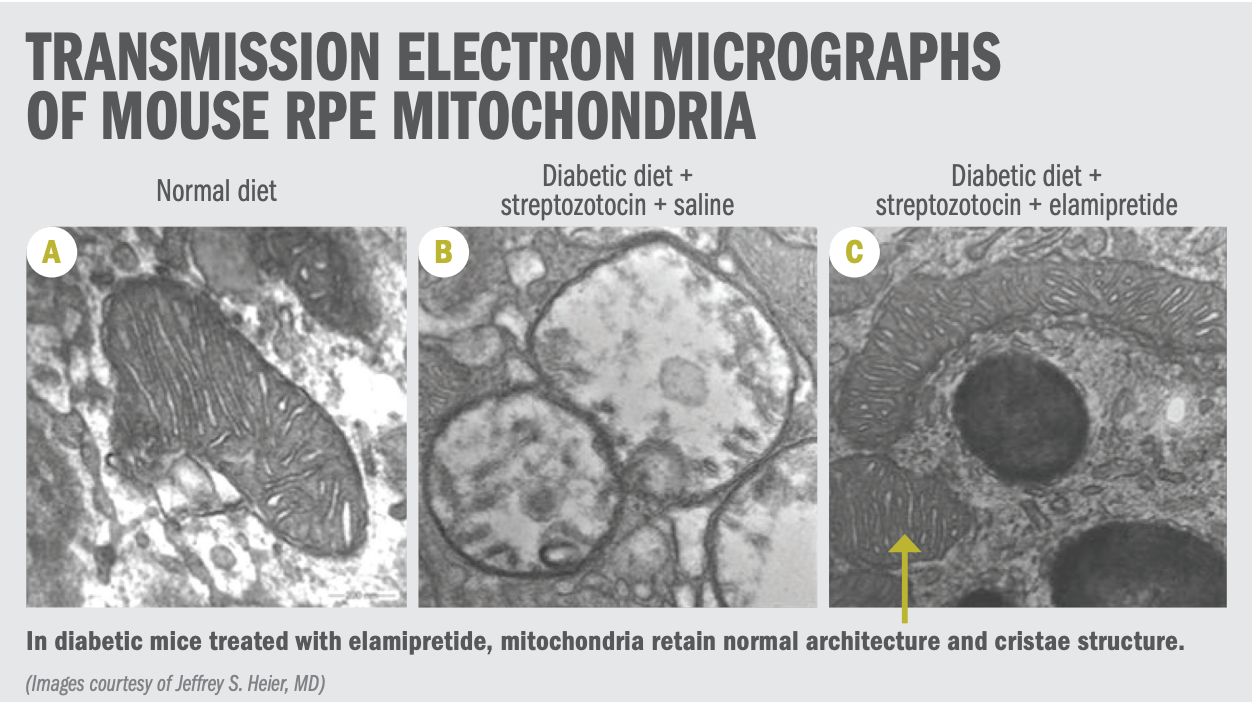Publication
Article
Digital Edition
Elamipretide: a mitochondrial protector
Author(s):
Trial shows treatment has acceptable safety profile, may improve visual function.

Reviewed by Jeffrey S. Heier, MD
Subcutaneous administration of elamipretide (MTP-131; Stealth BioTherapeutics Inc) to treat noncentral geographic atrophy in age-related macular degeneration (AMD) has been developed to restore mitochondrial function and morphology and offers promising potential as a treatment for geographic atrophy (GA), according to Jeffrey S. Heier, MD, director of vitreoretinal service and director of retinal research, Ophthalmic Consultants of Boston in Massachusetts.
Related: Investigators start pivotal subretinal gene therapy trial
“Mitochondrial dysfunction has been implicated in the pathogenesis of numerous diseases, and elamipretide is essentially a mitochondrial protector that has been studied in many ocular and nonocular diseases, such as Fuchs dystrophy, heart failure, mitochondrial myopathy, and even rare cardiomyopathies such as Barth syndrome,” he said.
What is known is that progressive mitochondrial abnormalities occur in the retinal pigment epithelium of numerous diseases; in fact, AMD investigators have determined that there are decreases in the numbers of mitochondria and the mean mitochondrial area in each cell, as well as the numbers of cristae in each mitochondrion, Heier explained.
Significant differences in the mitochondrial morphology are apparent in electron microscopy images in patients with AMD who exhibit severe mitochondrial disorganization compared with patients with normal changes resulting from aging.
Related: Testing HP-ß-CD as potential AMD therapy with cholesterol-lowering capabilities
Ghost mitochondria, extensive loss of cristae and matrix density, and mitochondrial bleb formation characterized by swelling and breakdown of mitochondria have been observed, according to Heier.
These changes happen as the result of increased reactive oxygen species that damage the phospholipid cardiolipin in the inner mitochondrial membrane, resulting in subsequent loss of cristae curvature and disruption of the respiratory complexes leading to apoptosis.
Heier pointed out that this is where elamipretide comes in.
“The drug binds to the cardiolipin to stabilize the inner mitochondrial membrane structure, thus allowing the cardiolipin to maintain the curvature,” he said. “This results in a return to normal or relatively normal function.”
Related: Regeneration may help restore vision in inherited retinal dystrophies
Phase 1 and 2 trials
The phase 1 ReCLAIM study (NCT03891875) demonstrated the safety of subcutaneous elamipretide for treating intermediate AMD and GA.
Scott Cousins, MD, the Robert Machemer, MD, Distinguished Professor of Ophthalmology, professor of immunology, and director of the Duke Center for Macular Diseases at Duke University in Durham, North Carolina, designed this study of noncentral GA without choroidal neovascularization, the study focus, and patients with high-risk drusen. Patients received 40 mg of subcutaneous elamipretide daily.
Most adverse events were associated with the injection site. Of the 21 enrolled patients, 15 completed the study.
Related: Raising the retinal disease treatment bar with genetic testing
The best-corrected visual acuity (BCVA) and low-luminance visual acuity (VA) improved by about 5 letters following treatment; the best-corrected reading VA did not change and there was a small benefit in the low-luminance reading VA.
The phase 2 ReCLAIM study of elamipretide also is focused on noncentral GA and is evaluating patients randomized 2:1 to 40 mg of subcutaneous treatment compared with placebo.
The primary end point at week 48 is the status of the low-luminance VA; the secondary end points are the BCVA, low-luminance reading VA, and changes in the area of the GA. Thus far, 165 patients have been enrolled.
“The therapeutic effect of elamipretide occurs via restoration of mitochondrial bioenergetics, which is under study in ocular and nonocular diseases,” Heier concluded. “The open-label phase 1 trial showed that subcutaneous treatment has an acceptable safety profile and may improve visual function in patients with noncentral GA.”
Related: Gene therapy heralds new era for inherited retinal diseases
The phase 2 placebo-controlled trial is ongoing. The results are expected to be forthcoming in 2022.
--
Jeffrey S. Heier, MD
e:jsheier@eyeboston.com
This article is adapted from Heier’s presentation at the Bascom Palmer Angiogenesis, Exudation, and Degeneration 2021 virtual conference. Heier is a scientific adviser to Stealth BioTherapeutics Inc.

Newsletter
Don’t miss out—get Ophthalmology Times updates on the latest clinical advancements and expert interviews, straight to your inbox.





